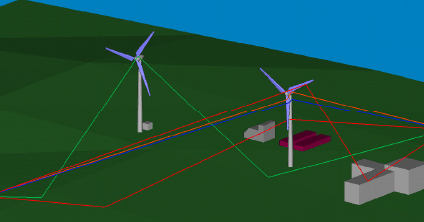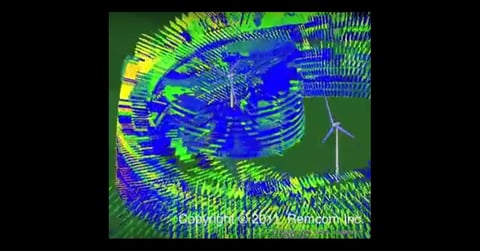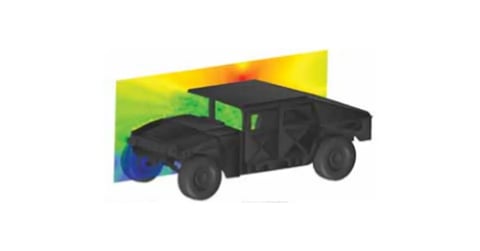- Products & Solutions
- XGtd
XGtd® High Frequency Antenna Analysis Software
XGtd® is a ray-based electromagnetic analysis tool for assessing the effects of a vehicle or vessel on antenna radiation, predicting coupling between antennas, and predicting radar cross section (RCS). It is ideally suited for applications with higher frequencies or very large platforms where the requirements of a full physics method may exceed available computational resources.

EM Simulation Software Demonstrations
Let a Remcom expert show you how our software can benefit your application.
XGtd Ray-based EM Analysis Software Features
XGtd’s capabilities extend well beyond standard ray tracing codes, incorporating techniques including Geometric Optics (GO), the Uniform Theory of Diffraction (UTD), Physical Optics (PO), and the Method of Equivalent Currents (MEC). XGtd provides high-fidelity outputs tailored to its intended applications.

Computational methods include:
- Ray tracing methods: Shooting and bouncing ray and image theory
- E-field evaluations using UTD, GO, PO, and MEC
- High-fidelity field predictions in shadow zones including creeping wave effects
- Multipath calculations including reflections, transmissions, wedge diffractions, surface diffractions, and creeping waves
X3D RCS Model
X3D RCS Model is a GPU-accelerated, multi-threaded 3D propagation model providing highly optimized calculations for far zone radar cross section (RCS) analysis, using methods based on Physical Optics (PO), the Method of Equivalent Currents (MEC), and the Uniform Theory of Diffraction (UTD).
Full 3D Model
The Full 3D propagation model predicts the paths by which energy travels from the transmitting antenna to the receiving location. This model supports interactions with structures in the near zone for applications such asco-site interference analysis, anechoic chamber analysis, or far zone antenna radiation from a platform-mounted antenna. It also provides an alternative method for predicting far zone RCS.
Graphical User Interface
XGtd's modular 64-bit GUI makes it easy to import objects to set up projects for various electrical large platforms. Users can simulate co-site analysis, antenna placement, radar cross section, and anechoic chambers.
Feature Import
Support for KMZ, COLLADA, STL and DXF formats for object import.
Large Platform Simulations
XGtd’s methods are less impacted by the platform’s electrical size than full wave techniques, supporting larger structures and higher frequencies.
Ray Path Visualization
Display ray paths for far zone antenna gain, RCS calculations, or antenna coupling. Rays are colored according to strength, allowing users to identify scattering features.
XFdtd Compatibility for Higher Fidelity Antenna Patterns
Calculate antenna radiation patterns for complex antenna designs using XFdtd. Import into XGtd to determine effects of placement on electrically-large platforms.
Antennas
Import simulated antennas from XFdtd or create textbook antennas for use as transmitters and receivers.
Materials
Electrical properties of the scene can be defined down to the facet level. An installed database of materials includes metal and absorbers.
Outputs
Users have quick access to outputs such as direction-of-arrival, complex impulse response, E-field vs. time, and E-field vs. frequency for each transmitter-receiver link. These ASCII-based files can be plotted in the tool or easily post-processed externally. S-parameters are exported to touchstone.

Antenna Placement
Remcom’s antenna modeling software tools ensure proper design and placement of antennas in almost any application. Our simulation tools can work alone or together for a complete analysis of how an antenna will perform.
Antenna Placement
Radar and Scattering
Remcom’s software products are important tools for analyses including Radar Cross Section (RCS) computation, radar antenna design, and scattering applications.
Radar and Scattering
Wind Turbine
Remcom's radar scattering tools measure the impact that wind turbines and wind farms have on radar returns for Air Traffic Control (ATC) radar, early warning radar, weather radar, and instrumentation radar.
Wind Turbine-

Application Examples
Antenna Coupling Simulation for Aircraft Circular Patch Antennas
This example analyzes the coupling between four circular patch antennas mounted on the sides of a Boeing 757. The antennas transmit and receive at a frequency of 2.4 GHz. Coupling between each antenna is characterized using XGtd’s S-Parameter output, which can be displayed in the user interface or exported to a v1.1 Touchstone file.
Explore Resource
Application Examples
RCS of Hellfire Missile: Comparison of X3D PO MEC to XFdtd
This example details the setup and execution of RCS calculations using XGtd’s X3D PO MEC model and compares the predictions to those made using XFdtd.
Explore Resource
Application Examples
How XGtd Calculates Antenna Gain on a Large Spacecraft
This example demonstrates XGtd's abilities to import geometry from CAD files and calculate received power and far zone antenna gain patterns for a transmitter located in the cargo bay of the space shuttle.
Explore Resource -

Videos
Using WaveFarer Radar Simulation Software to Predict How Waves Propagate in an Indoor Environment
Using WaveFarer's included scripts, users can leverage Remcom's XGtd path viewer to generate ray path animations. This clip demonstrates the capability by showing backscatter in an indoor scenario, visualizing how waves diffract through doorways and penetrate walls.
Explore Resource
Videos
Wind Turbines and Aircraft in the Presence of Ground Clutter
This short animation shows predicted RCS from an air traffic control radar with an aircraft flying over a wind farm, before and after the static ground clutter (returns from terrain) are filtered out.
Explore Resource
Videos
Simulating Multipath between Wind Turbines
Remcom’s XGtd can simulate the propagation paths of fields interacting with two wind turbines in close proximity. XGtd then generates a movie that shows the directions and magnitudes of the strongest propagation paths, including multipath occurring between the turbines.
Explore Resource -

Publications
Modeling the Effects of Wind Turbines on Radar Returns
Wind turbines located near radar installations can significantly interfere with a radar’s ability to detect its intended targets. Remcom’s XGtd software is a high frequency solver capable of calculating the radar cross section of electrically large objects. In this paper, interference from wind turbines is predicted using XGtd simulations.
Explore Resource
Publications
Using a Virtual Simulation Model of the Benefield Anechoic Facility in EW Testing
This paper presents the major components of the “Virtual BAF” simulation model as well as a few examples of its use in preliminary test design and setup.
Explore Resource
Publications
Using Simulation to Optimize Safety, Performance, and Cost Savings When Integrating an Antenna Onto a Platform
Successful integration of an antenna onto a vehicle platform poses many challenges. This paper provides a variety of examples of how modeling and simulation can be used to analyze antenna performance, identify problems, and evaluate potential solutions.
Explore Resource -

Brochures
XGtd® High Frequency Antenna Analysis Software Brochure
XGtd is a general purpose ray-based electromagnetic analysis tool for assessing the effects of a vehicle or vessel on antenna radiation, estimating radar cross section (RCS), and predicting coupling between antennas. Based on Geometric Optics and the Uniform Geometrical Theory of Diffraction (GTD/UTD), it is ideally suited to applications with higher frequencies or very large platforms where the electrical size of a computation may be too large for full physics techniques, such as Finite Difference Time Domain (FDTD).
Explore Resource
Brochures
XGtd® High Frequency Antenna Analysis Software Overview
XGtd® is a general purpose ray-based electromagnetic analysis tool for assessing the effects of a vehicle or vessel on antenna radiation, predicting coupling between antennas, and predicting radar cross section (RCS).
Explore Resource
XGtd Specifications
XGtd Capabilities
Contact us for additional capability information or to discuss your specific needs.
Standard Capabilities and Key Features
-
X3D RCS Model with GPU and mutli-processing for fast computations up to 100 GHz
-
Full 3D ray tracing solver, based on Uniform Theory of Diffraction (UTD) with corrections for finite conductivity materials, including thin coatings
-
Ideal solver for electrically-large platform models or scenarios
-
Plane wave phase reference
-
Creeping-wave diffraction computation for high-fidelity computation of fields in shadow zones
-
Compute far zone radiation patterns including effects of scattering from electrically-large platforms and nearby objects
-
Accurate monostatic and bistatic RCS of electrically-large platforms using Method of Equivalent Currents (MEC) and Physical Optics (PO)
-
Calculate doppler shift due to motion of transmitter or receiver
-
Analyze antenna coupling and interference at multiple frequencies
-
Import complex antenna patterns from Remcom’s XFdtd or other sources and standard formats, incorporating full polarization and phase information
-
Model wideband or narrowband pulses
-
Generate time or frequency domain output
-
Analyze propagation in anechoic chambers
-
Model transmitters as point sources, antenna arrays, distributed sources and plane waves
Optimization and Parallel-Processing
-
64-bit version: larger, more complex models and factor of 1.5 to 2 times speedup
-
Optimized Ray Engine: speed improvement for large or complex models
-
Run calculations on multiple processors, with 8 multi-process tokens included in base price
-
Linux and Windows clusters
Graphical User Interface and Visualization
-
64-bit GUI
-
Drag project elements with the mouse in the project view
-
Color displays of most output
-
Visualization of edges considered by the calculation to be part of curved surfaces
-
Use the powerful GUI to set up a calculation and display all results
-
3D visualization of near zone fields and far zone antenna patterns
-
3D display of ray paths
-
Color display of electric fields, received power and other output
-
Display 3D antenna patterns
-
Line plotting tools
-
Polar plots of antenna patterns
-
Color display of transient electric fields
-
"Movie Sequence" of transient fields vs. time
-
Export "Movie Sequence" to MPEG file
-
Export views and graphs to JPEG and TIFF files
Geometry Generation and CAD Import
-
KMZ and COLLADA support
-
DXF, STL and SAT formats
-
Automated CAD model simplification and error checking
-
Graphical geometry editor
-
Geometry validation
-
Translate, scale, rotate operations
-
Assign material properties
Materials
-
Create multiple material plots in one step
-
Multiple dielectric layers
-
Thin coatings
-
Imported reflection and transmission coefficients
-
Radiation Absorbent Material (RAM) types for anechoic chambers
Transmitters, Receivers and Waveforms
-
Transceivers: Simple co-location of functionally independent transmitters and receivers
-
Define transmitter and receiver sets on linear, planar or spherical surfaces
-
Define trajectories for transmitters or receivers
-
Sinusoidal waveforms or wideband pulses
-
Plane wave sources
-
Define transmitter and receiver antennas
Antenna Pattern Definition
-
Synthesize antenna array patterns from similar array elements
-
Numerous built-in antenna types
-
Ability to import XFdtd far zone patterns
-
Ability to import standard formats: NSMA, Odyssey, MSI Planet
-
Support for user-defined 2-cut plane antenna patterns
-
Linearly and circularly polarized source antennas
-
Ability to construct arrays from individual antenna elements
Output Types
-
S-Parameter output
-
Touchstone file export
-
Scattering amplitudes and excess times of arrival for RCS ray paths
-
Far zone ray paths, electric field magnitude and phase, complex impulse response, and poynting vector
-
Antenna gain patterns (effective far zone, including platform effects)
-
Radar cross section
-
Doppler shift
-
Received power
-
Time and frequency domain electric and magnetic fields
-
Electric field magnitude and phase
-
Poynting vector
-
Path loss
-
Ray path data (field levels, time-of-arrival, direction-of-arrival)
-
Complex impulse response
-
Carrier/interferer ratio
-
Power delay profile
-
Delay spread
-
Field animations
Libraries
-
Create stored libraries of antennas, materials and waveforms
System Requirements
GUI - Supported Platforms:
- Microsoft Windows 7, Windows 8, and Windows 10, 64- bit
Computation Engine - Supported Platforms:
- Microsoft Windows 7, Windows 8, Windows 10, 64-bit
- Red Hat Enterprise Linux 6, 64-bit (and compatible systems)
XGtd Professional Support
One year of Remcom Professional Support (RPS) is included with each product you purchase. Maintaining your license ensures that you will always have access to technical support and that you receive free product upgrades!
- Personal attention: speak directly with our engineers
- Product upgrades included
- Issue resolution, including escalation to higher management if necessary
- Toll-free phone and email support availability
Support is available from 9am-5pm Eastern Time, Monday-Friday.
